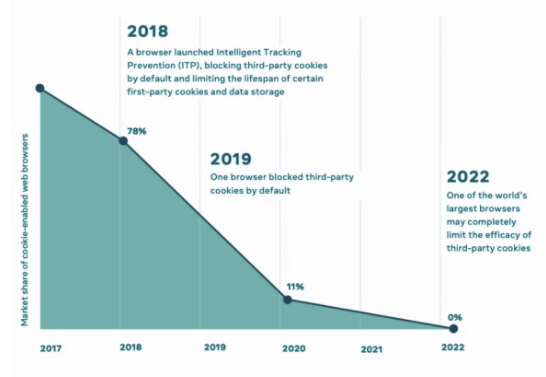This is the second article in a series of 7. Here we are building further on the article ‘Cookieless Series Part 1 - How ITP & GDPR are affecting your marketing results’, where we’ve set the scene on today’s constraints originating from ITP and GDPR. We will outline our vision on the future of advertising and how you should tackle it as an advertiser. The next articles in the series will go deeper into each of these topics separately.
The point-of-no-return
In the first half of 2020, Google made an announcement that created suspense among many advertisers. They are gradually working on a plan to phase-out 3rd party cookies from their browser, echoing the earlier decisions of both Safari and Firefox. With Chrome holding over half of the market share, we can therefore mark 2022 as a point-of-no-return. But let’s embrace the change. For all of their uses, third-party cookies have been an imperfect tool for marketers, leading to several recurring problems. As cookies are constantly deleted and there’s an inability to use cookies between devices, impressions are typically overstated and conversions undercounted. This leads to wasted ad spend and lost time in incremental frequency capping. Our way of thinking thus needs to pivot significantly.

Take action today by leveraging more first-party data
Let’s move forward: what can your business do now in order to avoid a total cookie-disaster?
- Collect first-party data: In the new marketing landscape, marketers and advertisers need to link and activate their customer data to more persistent IDs such as email, phone numbers, and customer IDs. This can be as easy as an email list coming from your CRM system, or more robust like a full Customer Data Platform deployment. The latter combines a wide range of data sources, both online and offline, in order to draw a 360° view of your customers. Consider the example of a website visitor who registered to your newsletter but is not yet a client. That person can be identified via his/her email, or any other unique id equivalent, and can already be mapped within your CDP. For a more detailed explanation, I suggest you read my colleagues’ article on ‘Why is the future of MarkTech Stack all about CDPs and not DMPs?’. One of the bigger challenges within larger organizations will be around data governance and responsibility. A strong collaboration between Marketing, IT, and Legal will be more crucial than ever before.
- Give users an incentive to log in: In a world where everything is dependent on user data, we need the user to log in at some point. Only then we will be able to stitch that user’s behavior to his/her ID. So when redesigning your website, this concept always needs to be top of mind. It’s all about building better products.
- Use Lookalike Audiences: as these are built 100% on first-party data and still leveraging the big data from walled gardens such as Google & Facebook. Lookalikes (or often called Similar audiences) are users that show similar traits to the people in your user base. They are created by smart algorithms and have proven to be very performant in the last couple of years. The more data, the stronger they get.
Next to that, don’t forget that ITP has no impact on Contextual targeting, Geo targeting and device targeting as no personal identifier is needed to obtain this information.
Take action tomorrow by getting ahead on the following topics
We want to alert you on some advanced topics that will be pivotal for the future of marketing. Note that this is just an introduction. Each topic will get covered in more detail by a separate article in this series.
- Probabilistic measurement and conversion modeling: This is not new, but will become more important over time. Vendors such as Google and Facebook try to estimate how much you were not able to measure (using benchmarks, etc) and try to fill the gaps based on the data you were able to capture. In this way of thinking, there is no such thing as exact measurement anymore, but rather statistical correctness. Read more about this topic in the article ‘Cookieless Series Part 3 - Probabilistic measurement - A world where uncertainty is the new normal’
- Facebook Conversion API: This solution claims to safeguard data-driven marketing when the Facebook Pixel will become obsolete over time. It basically comes down to migrating our measurement from client- to server-side, making cookies redundant. Furthermore, it will enable us to measure data coming from offline channels and CRM. Read more about this topic in the article ‘Cookieless Series Part 4 - Facebook Conversion API’
- GTM Server-side Tagging: Server-side tagging means running a Google Tag Manager container in a server-side environment (f.e: Google Cloud). The concept already exists for a while on other tech vendors (such as Tealium) but Google might open the door to the broader public. To put things simply, this initiative is conceptually similar to Facebook’s Conversion API but instead applicable to your full existing tag structure. This solution is still in its infancy, but we expect it to grow a lot throughout 2021. Read more about this topic in the article ‘Cookieless Series Part 5 - GTM Server-side Tagging’
- CRO Impact and AB Tests: Today cookies are also leveraged by AB testing tools. What will the impact on those tools be in the future? Are there alternative solutions at hand? Read more about this topic in the article ‘Cookieless Series Part 6 - The impact on CRO and AB Testing’
- Google’s Privacy Sandbox: The Privacy Sandbox project’s mission is to ‘Create a thriving web ecosystem that is respectful of users and privacy by default.’ Their main challenge exists in finding an alternative for third-party cookie-based conversion measurement and targeting (f.e: remarketing). Important acronyms such as FLoC and TURTLE-DOV might grow to unorthodox solutions to improve tomorrow’s digital world. Read more about this topic in the article ‘Cookieless Series Part 7 - Google’s Privacy Sandbox’
On an ending note: much more is currently at stake between DSPs, SSPs, and DMPs regarding a cookieless world. We hear terminology such as ID consortiums, User-based tracking, First-party bitstreams & The Matching Principle. Currently, we can only agree that the future of ad tech is uncertain and will get clearer in due time. From our end, let’s focus on what we can change today: the way we treat first-party data and our mindset.
